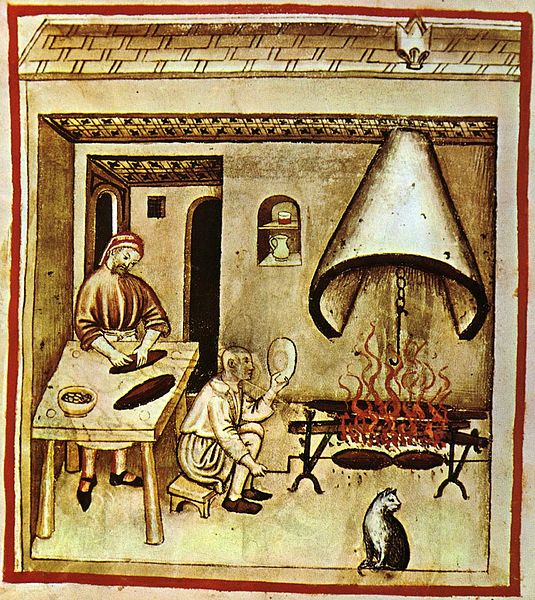Beef Pot Roast, adapted from 16th century recipes using techniques suggested by Cooks Illustrated.
“Take faire ffresh beef, and (if thou wilt) roste hit til hit be nygh ynowe; theñ put hit in a faire possenet”
Beef chuck, garlic, thyme, bay, bacon, horseradish root, gelatin leaves, celery root, onion, wine, S&P, stock, parsley, carrots and turnips (I decided not to use the potatoes after the picture was taken). Not shown: barley, barley malt, mushrooms and flour.
Following the natural seam, pull/cut the roast in two. Trim away thickest fat, but leave some thin layers intact.
Sprinkle roasts on all sides with kosher salt and place on a rack to rest for 1 hour at room temperature. After about 15 minutes, you will begin to see moisture (containing sugars and proteins) forming on the surfaces of the meat. The osmotic effect will begin to reverse after about 30 minutes as the salt partially dissolves and the liquids are reabsorbed. Salting the meat helps to ensure a proper Maillard reaction which is critical to the success of this recipe.
While the meat is resting, cut the bacon into 1/2 inch dice and cook over medium-low heat in a Dutch oven until all the fat is rendered, about 10 minutes. Set cooked bacon aside and pour off all but about 2 tablespoons of the melted fat.
Meanwhile, reduce an entire bottle of decent red wine (more fruity than dry) until the volume is halved.
Blot any remaining moisture from meat, pepper it on all sides and brown well on all sides in the bacon fat. Remove from pan and set aside.
Using the same pan, cook the onions until tender, about 5 minutes. Add garlic, cooked bacon and about 1 tablespoon of flour and cook another minute.
Add reduced wine and broth to the pan with the onions, scraping the sides and bottom to release the fond.
Put the browned meat and its juices into the pot. Seal the pot with foil, cover and place into a 300 degree oven for 1 hour.
After 1 hour, remove the pot from the oven and turn the meat over. Replace foil and lid and put back into the oven for another hour.
Prep the rest of the ingredients- celery leaves, stalks, celery root, carrots, barley, mushrooms and turnips.
After 2 hours of cooking, remove the pan from the oven. Transfer the meat to a rack and cover with the foil to keep warm.
Turn up the heat on the cooking liquid and reduce its volume by half.
Meanwhile, saute the celery root and turnips in butter until soft, about 10 minutes. Add this to the pot of cooking liquid.
Saute carrots and celery stalks in butter until browned, about 5 minutes. Glaze with a spoonful of barley malt before transferring to the pot with the turnips.
Salt the mushrooms and saute in butter until browned and most of the liquid has evaporated, about 5 minutes. Add the mushrooms to the pot with the rest of the vegetables.
Add the cold-water softened gelatin to the pot and stir until dissolved.
Cut meat into thick slices and ladle gravy and vegetables over the top. Garnish with chopped celery leaves and grated horseradish and serve accompanied with a glass of wine and a dish of hot, roasted chestnuts.
By far the best pot roast and one of the most satisfying meals in recent memory.

Rating ♦ ♦ ♦ ♦ ♦
















































